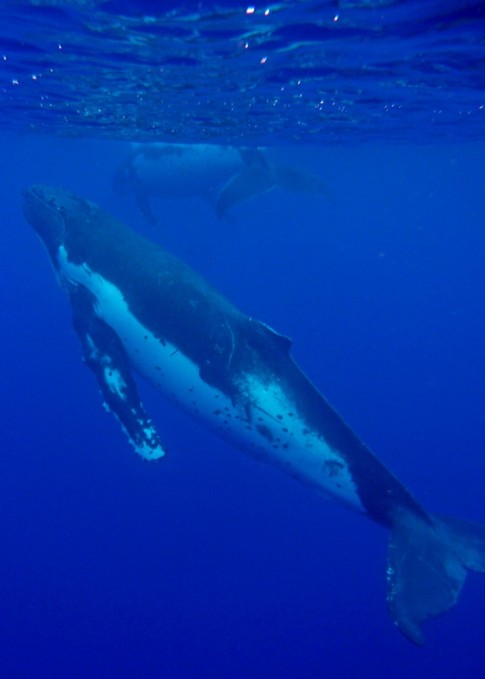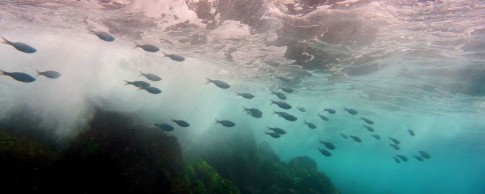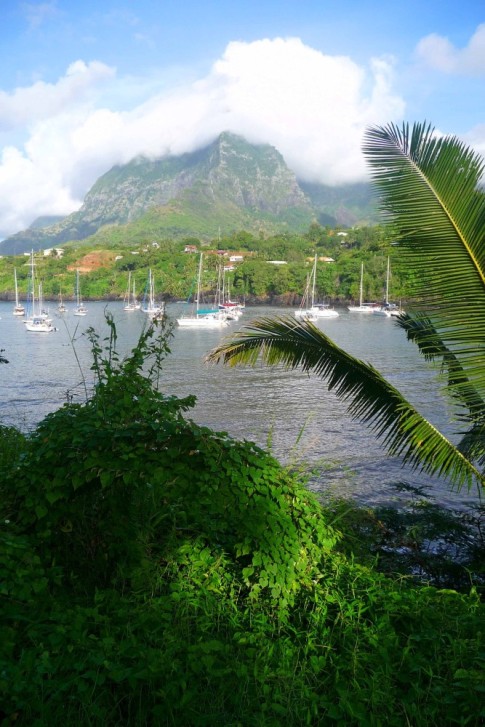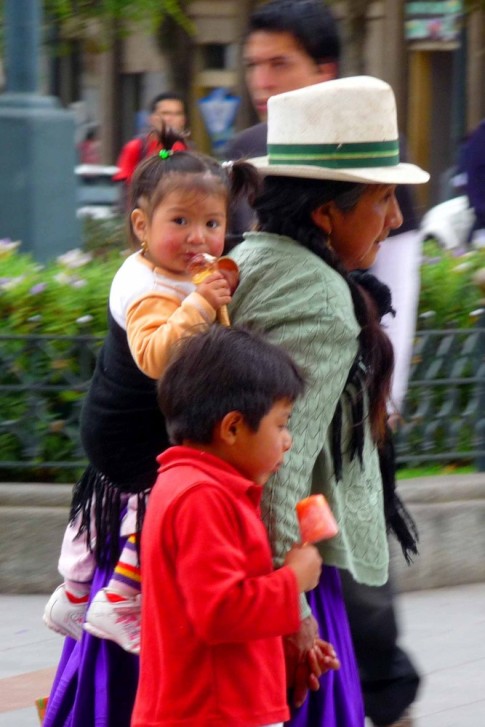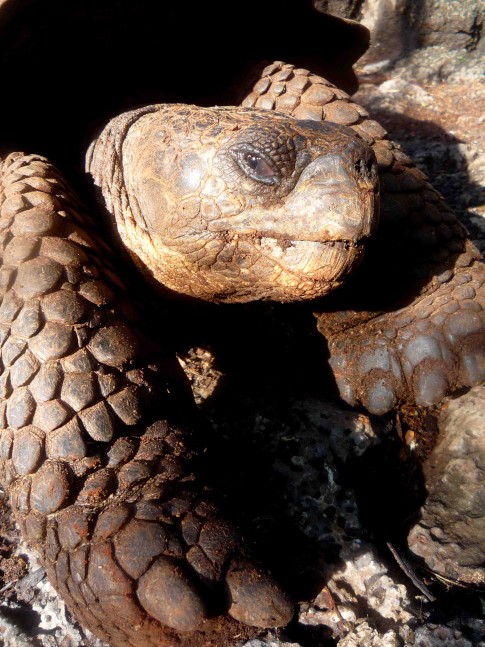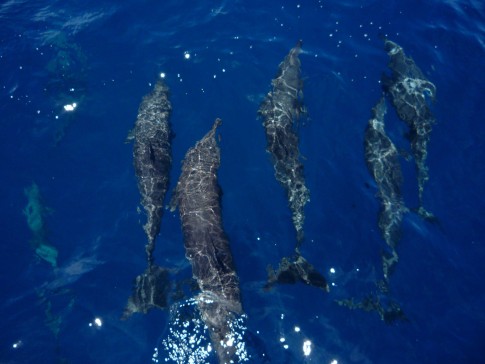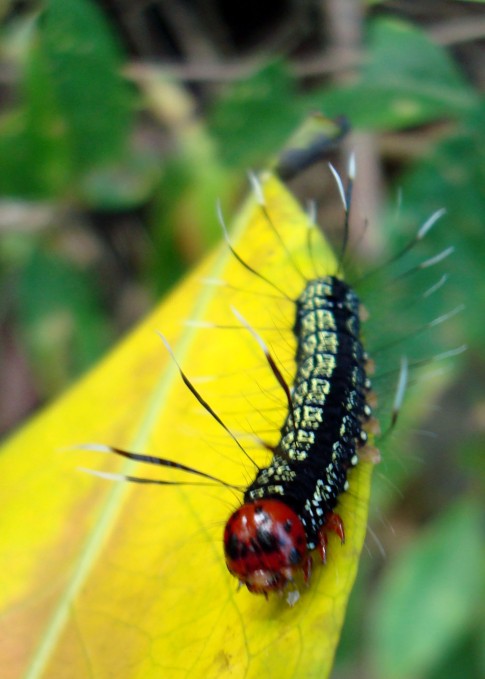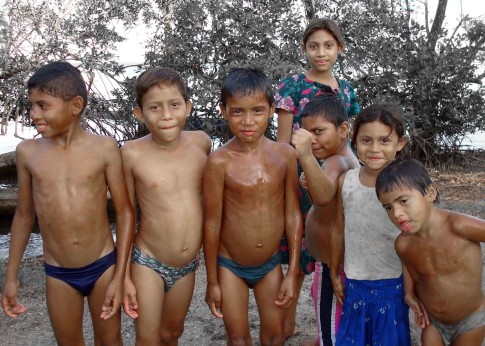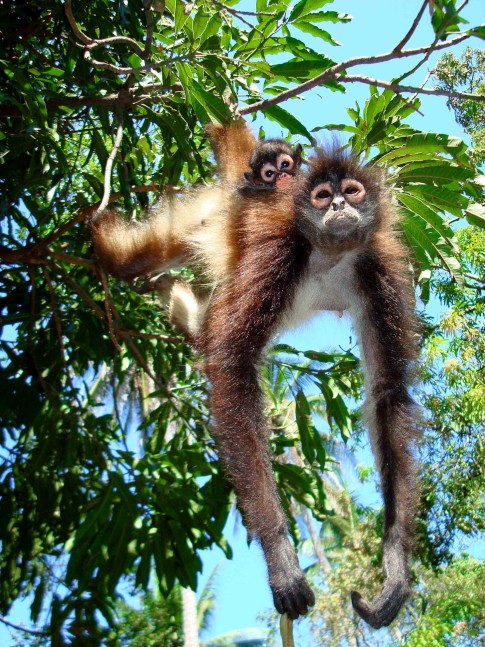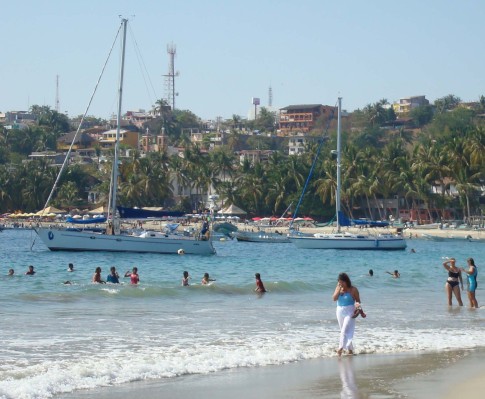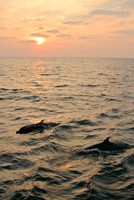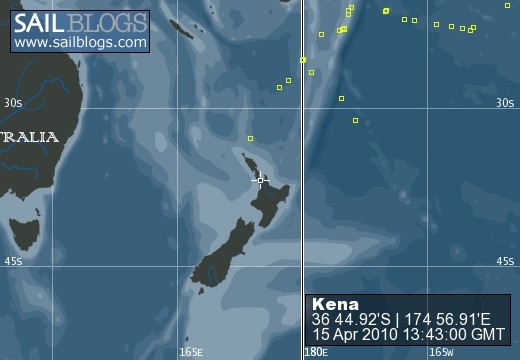
Kena
22 November 2009 | Tutukaka
11 November 2009
10 November 2009
09 November 2009
07 November 2009
07 November 2009
04 November 2009
03 November 2009
01 October 2009
29 September 2009
05 September 2009 | Nuku'alofa
27 August 2009
27 August 2009
23 August 2009
16 August 2009
14 August 2009
12 August 2009
09 August 2009
08 August 2009
08 August 2009
Isla Baltra and Isla Isabela
15 April 2008
Roger
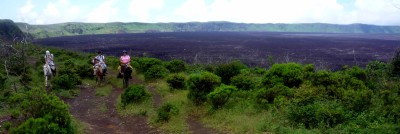
We awoke anchored off Isla Baltra, which is north of and just next to Isla Santa Cruz. This is where the ship is refueled, and in the process of watching this, we saw sharks swimming around the ship. After refueling, we all went ashore to a bus, then to a small ferry terminal to cross to Santa Cruz, then to the highlands to see Gemelos---two huge craters in the forest, one on each side of the road across to Puerto Ayora. They were thought to be volcanic craters, but it is now known that they are cave-ins on a lava tube---since they are hundreds of feet deep, and a couple of hundred yards across, the lava tube must be massive. The guide explained that it is, indeed, massive, and that it is possible to descend into the craters, then find your way into the tube and make your way underground to the sea, several miles away.
We were the only people not going to the airport at the end of the trip, so we hitched a ride with one of the guides on a bus that was returning to Puerto Ayora. There, we booked tickets on the fast ferry to Isabela and were told to be at the dock by 1pm. It was still only 10am, so we wandered around the town, checked out the souvenir shopping, booked a hotel on Isla Isabela, and had lunch. Back at the dock, we waited. And we waited. And we waited. At about 2:30pm, we were told the boat was ready and took our bags down to it. The �fast ferry�turned out to be a small speedboat with a single 115hp outboard. We had seen several others departing, but each of those had two, three, and four outboards, great security if one engine fails. After taking our bags on board, the crew (two guys) decided they needed to fill up, so the boat moved to another dock and we walked around to watch the process. Fueling was done from large plastic drums, by syphon. In the middle of the process the hose came out and gasoline poured over the aft end of the boat. There was much shouting, the boat drifted off nearly pulling the drum over with the syphon hose, but finally things were under controal and fueling finished. We (Sal, Tane, and I) and three young Danish guys with hangovers, went back to the main dock and boarded. One of the crew then loaded on his young wife and two-year-old, and we were off. They had a hand-held GPS and a compass, but no radio, and it was 3pm by the time we left. There was a significant sea running, so at over 20 knots, we were flying off the waves and crashing down fairly frequently, although I was amazed at how well such a small boat handled the seas. The trip is over 60 nautical miles of open ocean between Santa Cruz and Isabela, so our fellow passengers with the hangovers had quite a time for three hours! It was dusk when we picked our way through the rocks to Puerto Villamil, on the way stopping to view the small colony of Galapagos penguins near the entrance---they are quite small, and only the penguins in New Zealand are smaller. It�s quite remarkable to see penguins at the equator... it is thought that they originally arrived with the cold Humboldt current coming up from the south, and became isolated here.
It was dark by the time we got off the dock, and we started walking. It soon became clear we had no idea where to go, so we headed back to the dock to get the crew to call a taxi for us. The hotel San Vicente was a welcome sight after the three hour bash at sea! We learned that the owner of the hotel is Vicente... it�s amusing that he named the hotel Saint Vincent! Perhaps he lives in hope of canonization. We arranged to be on Vincente�s tour of the Cerro Negro volcano the following day before turning in.
After breakfast, we were shown to a table where we made our own sandwiches for the trip. Then it was an hour drive up the lower slopes of the volcano through lush vegetation, then lava flows, then vegetation again. There is quite a bit of farming done in little patches in the forest beside the road, but from a distance there is no sign of it. Sal had chosen to ride a horse (a lesson learned in Guatemala), and we started the 14 kilometer hike. The caldera is huge... they claimed it is the largest active caldera in the world, and second only to the inactive Ngongoro in Tanzania. The volcanoes here are shield volcanoes, like those in Hawaii. This means they are not a pronounced cone, and their eruptions are characterized by flowing lava and are not explosive. The last eruption was in October, 2005. We walked on through a moonscape of ropey lava flows, smaller lava tunnels, and sharp lava fields to a couple of still fuming parasitic cones on the slopes of the main volcano. The view was incredible...you can see the few buildings of the town, but the rest of the island is either solid black lava flows or green with vegetation. Isabela, far and away the largest island in the Galapagos, is L-shaped and built by a series of volcanoes. The volcanoes are separated by open lava fields, so the giant tortoises are isolated on each volcano, evolving into separate subspecies on each. The small, still steaming, cones we visited have ferns growing in them, watered by the steam. Depending on the age of each lava field, there is either no sign of life except for lava lizards and spiders, through to significant vegetation including very old cacti.
The tour ended around 3pm, after which we took a short snorkeling trip to the Tintoreras, the rocks we had picked our way through in the ferry the evening before. We visited the penguins again... this time, they stood with their backs to us with their beaks pointing up... apparently they do this to avoid being seen, or at least they think they are not being seen. In any event, it�s quite comical. We went ashore to walk the Tintoreras trail, all spiky lava with white tips... the white is a lichen, not guano. The snorkeling visibility was not great, and Tane was the only one to see a Tintorera (white-tip shark). The area is a series of rocks with huecos (holes) with sandy bottoms, and when the water is not as warm as it is now, large numbers of the sharks lie in the holes on the sand. We did surprise the largest sea turtle we�ve ever seen (and it was huge), and managed to follow it under water for some time.
The following day we rented bikes and rode out to the wall of tears. Isabela was a prison island for some time, and one of the punishments was to make the prisoners work on a huge and completely purposeless wall of volcanic rock. On the way, we passed wetlands with flamingos, pozos (little lakes), sandy beaches. The shore is simply the lava flow disappearing into the sea, with the occasional coral sand beach and mangroves. There is an amazing lava tube that is about the size of a small subway tunnel. It snakes along the ground and out into the sea, where you can see it running 100 yards or so out into the water before it is too deep to follow any further. There is a cave-in on land where you can descend on steps into the tunnel and look into the darkness towards the sea.
Just as we got to the wall of tears, 7 kilometers from town, Sal�s rear tire blew out with a loud bang (and accompanying squawk). Tane and I rode back for a taxi, and we returned the bikes, only to learn that we had to pay for a tube and the taxi, and that we were lucky not to have to pay for a tire!
We spent the rest of the afternoon wandering around the town. The streets are all coral sand. When the streetlights come on in the evening, they help create a soft glowing light. There is very little traffic, so most people you see are walking.
At dinner at a restaurant that night, we met the Danish crew of a 47 foot steel sailboat. They told us they had been �kicked out�of the islands and had to leave for the Marquesas by 7am the following morning. This had something to do with their not getting the correct permits. Their actual plan was to return to the mainland (Bahia Caraquez) where they had come from, but apparently that is not officially possible for them.
We�d arranged for a small plane flight back to San Cristobal the next afternoon at 1pm. At breakfast that morning, Vicente told us the airline had called and the flight had been changed to 10am! I suppose they could be reasonably certain we could be contacted, but we wondered what would have happened had we turned up at the original time. The flight back gave us some really great views of the islands, and we were pleased to see Kena still swinging at anchor as we made the approach. We also saw that Cutty Wren was still there... we�ve learned that they�ve only just received their part, so it will still be a day or so before they leave for the Marquesas.
The excursion has been great, but it�s also wonderful to be back on board. We sat in the cockpit in the evening, watching the sun set and listening to the sealions around us. All day and all night, you can hear them sneezing, bubbling, splashing, coughing, and barking (a sound like throwing up). There are always one or two of them around our boat, and it appears that they deliberately blow bubbles under the boat. It�s all very entertaining as long as they�re not sitting in your dinghy!
We were the only people not going to the airport at the end of the trip, so we hitched a ride with one of the guides on a bus that was returning to Puerto Ayora. There, we booked tickets on the fast ferry to Isabela and were told to be at the dock by 1pm. It was still only 10am, so we wandered around the town, checked out the souvenir shopping, booked a hotel on Isla Isabela, and had lunch. Back at the dock, we waited. And we waited. And we waited. At about 2:30pm, we were told the boat was ready and took our bags down to it. The �fast ferry�turned out to be a small speedboat with a single 115hp outboard. We had seen several others departing, but each of those had two, three, and four outboards, great security if one engine fails. After taking our bags on board, the crew (two guys) decided they needed to fill up, so the boat moved to another dock and we walked around to watch the process. Fueling was done from large plastic drums, by syphon. In the middle of the process the hose came out and gasoline poured over the aft end of the boat. There was much shouting, the boat drifted off nearly pulling the drum over with the syphon hose, but finally things were under controal and fueling finished. We (Sal, Tane, and I) and three young Danish guys with hangovers, went back to the main dock and boarded. One of the crew then loaded on his young wife and two-year-old, and we were off. They had a hand-held GPS and a compass, but no radio, and it was 3pm by the time we left. There was a significant sea running, so at over 20 knots, we were flying off the waves and crashing down fairly frequently, although I was amazed at how well such a small boat handled the seas. The trip is over 60 nautical miles of open ocean between Santa Cruz and Isabela, so our fellow passengers with the hangovers had quite a time for three hours! It was dusk when we picked our way through the rocks to Puerto Villamil, on the way stopping to view the small colony of Galapagos penguins near the entrance---they are quite small, and only the penguins in New Zealand are smaller. It�s quite remarkable to see penguins at the equator... it is thought that they originally arrived with the cold Humboldt current coming up from the south, and became isolated here.
It was dark by the time we got off the dock, and we started walking. It soon became clear we had no idea where to go, so we headed back to the dock to get the crew to call a taxi for us. The hotel San Vicente was a welcome sight after the three hour bash at sea! We learned that the owner of the hotel is Vicente... it�s amusing that he named the hotel Saint Vincent! Perhaps he lives in hope of canonization. We arranged to be on Vincente�s tour of the Cerro Negro volcano the following day before turning in.
After breakfast, we were shown to a table where we made our own sandwiches for the trip. Then it was an hour drive up the lower slopes of the volcano through lush vegetation, then lava flows, then vegetation again. There is quite a bit of farming done in little patches in the forest beside the road, but from a distance there is no sign of it. Sal had chosen to ride a horse (a lesson learned in Guatemala), and we started the 14 kilometer hike. The caldera is huge... they claimed it is the largest active caldera in the world, and second only to the inactive Ngongoro in Tanzania. The volcanoes here are shield volcanoes, like those in Hawaii. This means they are not a pronounced cone, and their eruptions are characterized by flowing lava and are not explosive. The last eruption was in October, 2005. We walked on through a moonscape of ropey lava flows, smaller lava tunnels, and sharp lava fields to a couple of still fuming parasitic cones on the slopes of the main volcano. The view was incredible...you can see the few buildings of the town, but the rest of the island is either solid black lava flows or green with vegetation. Isabela, far and away the largest island in the Galapagos, is L-shaped and built by a series of volcanoes. The volcanoes are separated by open lava fields, so the giant tortoises are isolated on each volcano, evolving into separate subspecies on each. The small, still steaming, cones we visited have ferns growing in them, watered by the steam. Depending on the age of each lava field, there is either no sign of life except for lava lizards and spiders, through to significant vegetation including very old cacti.
The tour ended around 3pm, after which we took a short snorkeling trip to the Tintoreras, the rocks we had picked our way through in the ferry the evening before. We visited the penguins again... this time, they stood with their backs to us with their beaks pointing up... apparently they do this to avoid being seen, or at least they think they are not being seen. In any event, it�s quite comical. We went ashore to walk the Tintoreras trail, all spiky lava with white tips... the white is a lichen, not guano. The snorkeling visibility was not great, and Tane was the only one to see a Tintorera (white-tip shark). The area is a series of rocks with huecos (holes) with sandy bottoms, and when the water is not as warm as it is now, large numbers of the sharks lie in the holes on the sand. We did surprise the largest sea turtle we�ve ever seen (and it was huge), and managed to follow it under water for some time.
The following day we rented bikes and rode out to the wall of tears. Isabela was a prison island for some time, and one of the punishments was to make the prisoners work on a huge and completely purposeless wall of volcanic rock. On the way, we passed wetlands with flamingos, pozos (little lakes), sandy beaches. The shore is simply the lava flow disappearing into the sea, with the occasional coral sand beach and mangroves. There is an amazing lava tube that is about the size of a small subway tunnel. It snakes along the ground and out into the sea, where you can see it running 100 yards or so out into the water before it is too deep to follow any further. There is a cave-in on land where you can descend on steps into the tunnel and look into the darkness towards the sea.
Just as we got to the wall of tears, 7 kilometers from town, Sal�s rear tire blew out with a loud bang (and accompanying squawk). Tane and I rode back for a taxi, and we returned the bikes, only to learn that we had to pay for a tube and the taxi, and that we were lucky not to have to pay for a tire!
We spent the rest of the afternoon wandering around the town. The streets are all coral sand. When the streetlights come on in the evening, they help create a soft glowing light. There is very little traffic, so most people you see are walking.
At dinner at a restaurant that night, we met the Danish crew of a 47 foot steel sailboat. They told us they had been �kicked out�of the islands and had to leave for the Marquesas by 7am the following morning. This had something to do with their not getting the correct permits. Their actual plan was to return to the mainland (Bahia Caraquez) where they had come from, but apparently that is not officially possible for them.
We�d arranged for a small plane flight back to San Cristobal the next afternoon at 1pm. At breakfast that morning, Vicente told us the airline had called and the flight had been changed to 10am! I suppose they could be reasonably certain we could be contacted, but we wondered what would have happened had we turned up at the original time. The flight back gave us some really great views of the islands, and we were pleased to see Kena still swinging at anchor as we made the approach. We also saw that Cutty Wren was still there... we�ve learned that they�ve only just received their part, so it will still be a day or so before they leave for the Marquesas.
The excursion has been great, but it�s also wonderful to be back on board. We sat in the cockpit in the evening, watching the sun set and listening to the sealions around us. All day and all night, you can hear them sneezing, bubbling, splashing, coughing, and barking (a sound like throwing up). There are always one or two of them around our boat, and it appears that they deliberately blow bubbles under the boat. It�s all very entertaining as long as they�re not sitting in your dinghy!
Comments
| Vessel Name: | Kena |
| Vessel Make/Model: | Ganley Pacemaker 40 |
| Hailing Port: | Tutukaka, New Zealand |
| Crew: | Roger, Sally, Tane, Hunters all |
| About: | The Hunter family: Roger, originally from Tutukaka, New Zealand Sally, from Tasmania, Australia and Tane is from New Mexico. |
| Extra: | This leg of the trip is from Puerto Lucia, Ecuador to New Zealand. |
Kena's Photos - Main
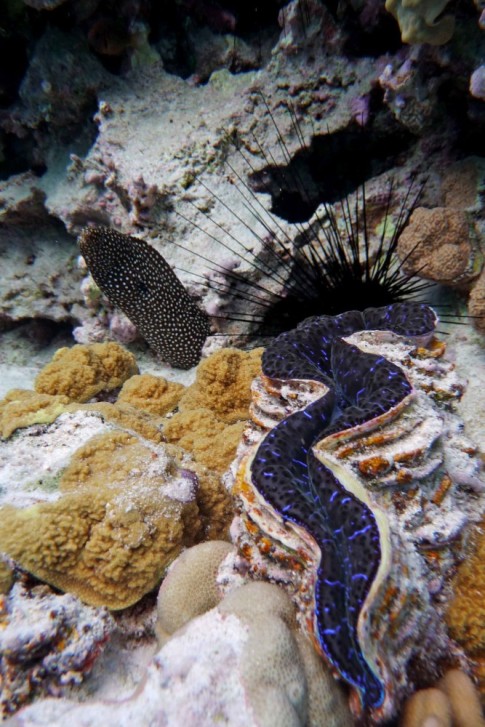 |
A few picks of Roratonga, where we picked up Tomas, and of the incredible Beveridge Reef
20 Photos
Created 1 September 2009
|
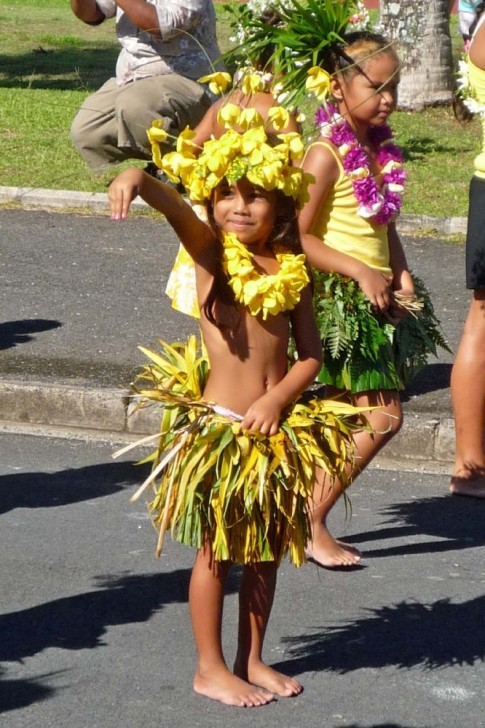 |
Our adventure in the islands of Tahaa and Raiatea in The Society Islands
18 Photos
Created 5 August 2009
|
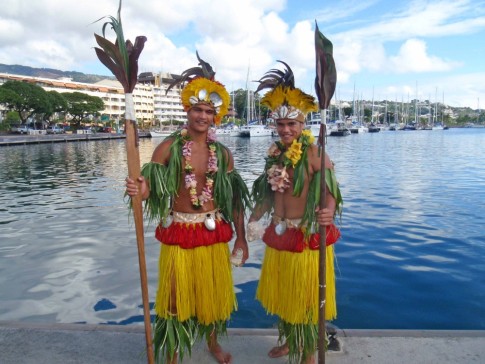 |
The Sailing Rendezvous in Tahiti and Moorea, plus a little of Huahine
35 Photos
Created 5 August 2009
|
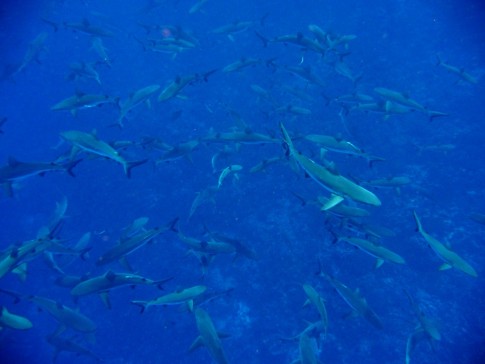 |
Our journey through the coral atolls of the Tuamotus in French Polynesia
65 Photos
Created 19 June 2009
|
S/V Kena
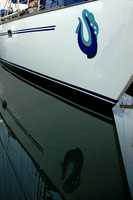
Who: Roger, Sally, Tane, Hunters all
Port: Tutukaka, New Zealand
